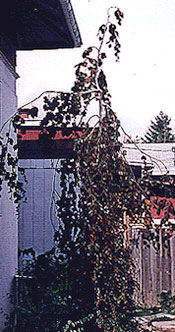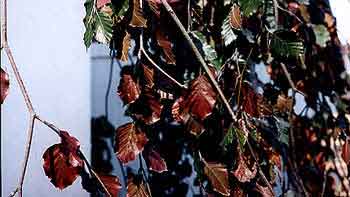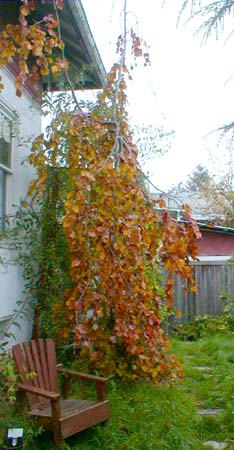 A Widow in Mourning:
A Widow in Mourning:
Black Swan Beech
"A brook ran murmuring beneath
The grateful twilight of the trees,
Where from the dripping pebbles swelled
A beech's mossy knees."
-James Matthew Legare
(1823-1859)
(1823-1859)
Here again our limited photography skills are a mite frustrating, as this Fagus sylvatica 'Black Swan' beech, named for its swan's neck growth habit, is one of the most beautiful things in any of our gardens, but the best picture we've so far gotten offers only an impression of the unusual shape. To show it on the web to complete advantage, we'll need to get portraits of it in various seasons, as there's just no way a single photograph, even a better one than we managed, could ever convey this tree's varying charms.
 The present page starts with two September portraits (2000 & 2001 respectively) when the leaves were fading from the deep black-purple of summer & had begun passing through every imaginable leaf color: copper, bronze, brown, & green, generally settling into a bright golden in late autumn. The close-up shown second is pretty good at indicating its early Autumn circus of shades.
The present page starts with two September portraits (2000 & 2001 respectively) when the leaves were fading from the deep black-purple of summer & had begun passing through every imaginable leaf color: copper, bronze, brown, & green, generally settling into a bright golden in late autumn. The close-up shown second is pretty good at indicating its early Autumn circus of shades.The third photo shows the leaf colors in November (2004), already about four feet taller. Additional portraits for its late-autumn appearance can be observed on the Black Swan Page of the Autumn Trees Gallery.
This beech's unusual habits have included, its first year in our yard, holding onto many of its leaves through much of the winter, which following autumn colorfulness turn completely brown & crisp but don't all fall for quite some while. But on our hilltop we get occasional high winds which during our Black Swan's later years have taken off most of the dry winter leaves, so this attribute is varied & some years it will hold many or a few of its leaves for much of winter, other years not even one.
 Weeping beeches are tremendous in winter for revealing their bent trunk & limbs & dangling twigs, encased in mottled bark, which can be appreciated on the 'Black Swan' Page of the Winter Bark Garden Walk. It also produces edible Beechnuts, pictured on the Beechnuts Page.
Weeping beeches are tremendous in winter for revealing their bent trunk & limbs & dangling twigs, encased in mottled bark, which can be appreciated on the 'Black Swan' Page of the Winter Bark Garden Walk. It also produces edible Beechnuts, pictured on the Beechnuts Page.Spring's new leaves are copper-colored at first blush, but quickly pass through shades of purple until by summer the leaves have darkened to purplish black. The summer appearance is that of a thin old woman in attitude of prayer, dressed in a mournful black lace dress with train that drags the ground. Then once more in Fall, as shown at the right in the second photo by Granny Artemis, the leaves fade back through an elaborate spectrum.
It also has an especially tight narrow habit. Planting any tree close to a house can be a risk, but I was personally adamant where I wanted a tree & had to find one that would be little or no threat even in its eventual old age. The tree is still new enough in America that the potential maximum height & thickness of trunk hasn't been fully assessed, though I'm gambling 25 feet is the mature height, as indicated by a Dutch grower, hence ours is approaching as tall as it'll ever be, & will gain in girth rather slowly. It presently reaches well above the "first eaves" of our two-story home with no indication of being a nuisance to the house, for it "weeps" so intensely that its limbs go straight down to the ground. What side-ways growth the Black Swan has put on has gone toward the morning sun away from the house.
The Black Swan was developed in Holland & is uncommon in the United States. The Oregon grower from whom ours was obtained phased out beeches to make room for more varieties of Japanese maples which are pricier & more profitable & sooner ready for market. In 2004 we were able to obtain one of the very last 'Black Swans' while helping out with a friend's landscaping. I'd make them a central feature at every landscaping job if they weren't so scarse. Japanese maples are of course exceedingly wonderful & ideal trees for the Pacific Northwest, but what a shame that beeches aren't allowed their equally desergved full share of attention.
There are so very many unusual beech cultivars it is hard to say any one of them is more beautiful than all the others, but the graceful slender shape makes 'Black Swan' one a good candidate for the best there is, & its seasonal changes make it almost antic in its continous demand to be noticed.
Beeches are among our favorites & we also have a Green Weeping Beech & a serated purple-leaf Rohani. If we had a much bigger property I'd collect as many beeches as possible! I hope at least to add a Purpurea Pendula someday, which only get to about ten feet tall & will fit in as a skinny shrub, but so far I haven't seen just the one that was just perfect & worth the price.
The only draw-back to beeches is they do get aphids, but we've found that ladybugs take care of those. Once, when aphids on the green weeping beech got ahead of the ladybugs, I stood on a ladder to squirt it with soapy water, then sprayed the tree clean the next day with a hose, & like magic no more aphids. So as problems go, the beech aphids haven't caused much worry.